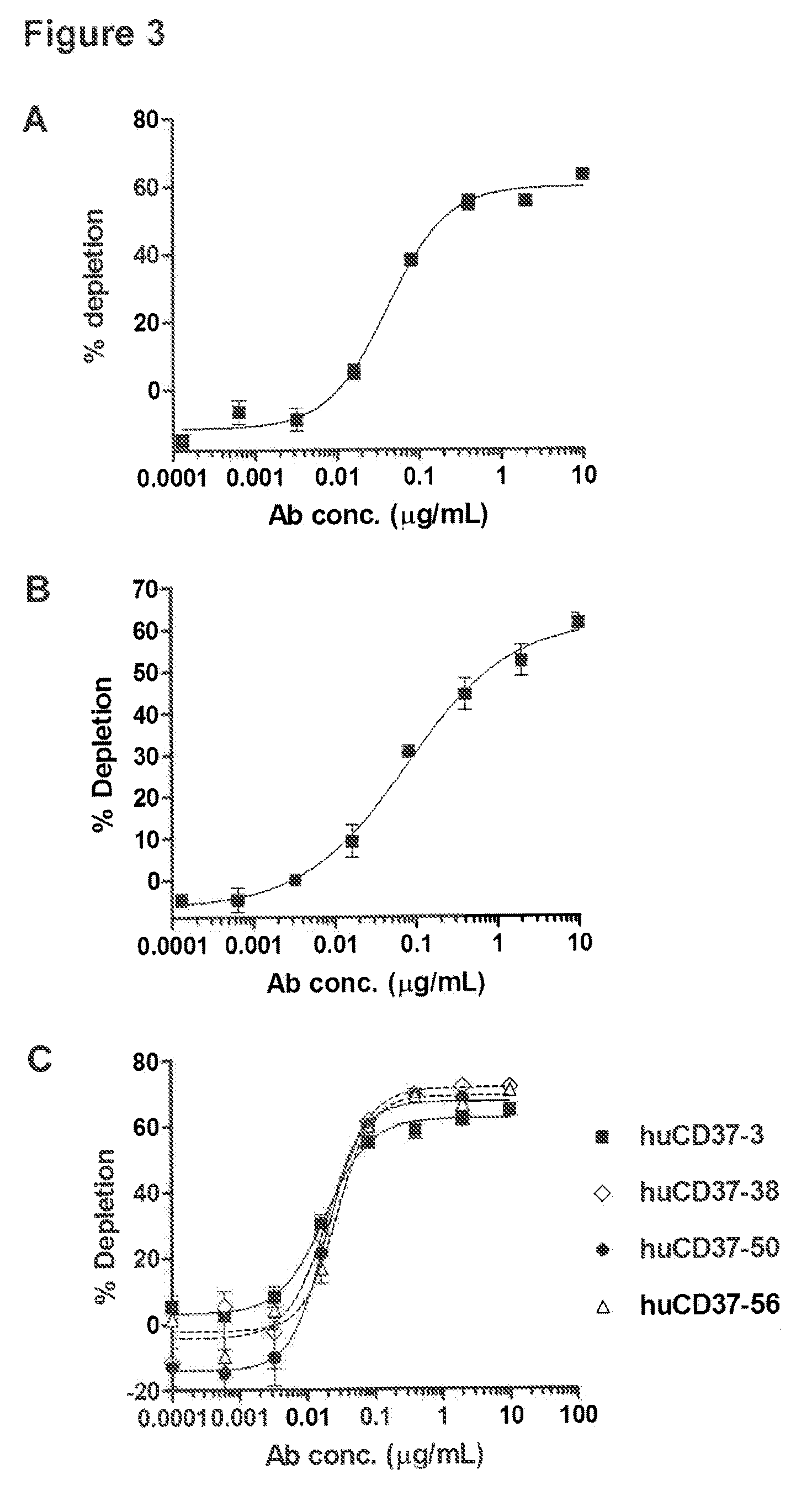CD37-Binding Molecules and Immunoconjugates Thereof
a technology of cd37 and binding molecules, which is applied in the field of antibodies, antigen-binding fragments thereof, polypeptides, and immunoconjugates, and can solve the problems of not all patients could be treated, no cdc activity has been described for any of these binding agents, and no in vitro pro-apoptotic activity
- Summary
- Abstract
- Description
- Claims
- Application Information
AI Technical Summary
Benefits of technology
Problems solved by technology
Method used
Image
Examples
example 1
CD37 Expression in Normal Human PBMCs
[0255]The CD37 antigen was reported to be expressed on B-cells from the pre-B stage to the peripheral mature B-cell stage, while being absent on B-cell progenitors and terminally differentiated plasma cells. (Link et al., 1987, J Pathol. 152:12-21). In addition, the CD37 antigen is only weakly expressed on T-cells, myeloid cells and granulocytes (Schwartz-Albiez et al. 1988, J. Immunol., 140(3)905-914).
[0256]The ability of antibodies (including certain CD37 antibodies and immunoconguates previously described in U.S. Published Application No. 2011 / 0256153, which is herein incorporated by reference in its entirety) to bind to normal human B-cells was measured using flow cytometry assays with fluorescently labeled antibodies. In addition, the commercially available QuantiBRITE system from BD Biosciences was used to estimate antigen density based on the number of antibodies bound to the cells (ABC). The QuantiBRITE system from BD Biosciences utilizes...
example 2a
In Vitro B-Cell Depletion Using Purified PBMCs
[0265]The ability of humanized antibodies to deplete B-cells was measured using: in vitro assays with human PBMCs according to published studies performed with rituximab (Vugmeyster et al. Cytometry A. 2003; 52(2):101-9 and Vugmeyster et al. Int Immunopharmacol. 2004; 4(8):1117-24). Alemtuzumab (Campath) was used as appositive control, since it has been reported to efficiently deplete lymphocytes in vivo and in vitro (Hale, Blood. 1983 October; 62(4):873-82 and Waldmann, Philos Trans R Soc Lond B Biol Sci. 2005 Sep. 29; 360(1461):1707-11).
[0266]Fresh buffy coats from healthy donors were obtained from Research Blood Components (Brighton, Mass., US) as a source of normal blood cells for all experiments within this study. Buffy coats were prepared by centrifugation of a unit of whole blood and collecting the interface between the plasma and the red blood cells. This unpurified buffy coat contains PBMCs, neutrophils, platelets, red blood cel...
example 2b
Dose Response for In Vitro B-Cell Depletion Using Purified PBMCs
[0271]To evaluate the dose-response of the antibodies and conjugates, purified PBMCs from 2 donors were incubated with a 5-fold sample dilution series. Each sample dilution was added at 10 μL per tube to 90 μL of purified cells in triplicate and incubated for 1 hour at 37° C. in a humidified 5% CO2 incubator. The final concentration ranged from 10 μg / mL to 0.13 ng / mL. The same amount of a non-binding huIgG Ab was used as an isotype control.
[0272]For two donors tested, treatment of purified PBMC samples with huCD37-3-SMCC-DM1 resulted in a clear dose-response for the B-cell depletion activity (see FIGS. 3A and B). Incubation with huCD37-3-SMCC-DM1 caused in vitro depletion of approximately 60% of B-cells with an EC50 of 40-75 ng / mL. For an additional donor tested, treatment of purified PBMC samples with huCD37-3, huCD37-38, huCD37-50, and huCD37-56 antibodies also resulted in a clear dose-response for the B-cell depletio...
PUM
| Property | Measurement | Unit |
|---|---|---|
| concentration | aaaaa | aaaaa |
| dissociation constant | aaaaa | aaaaa |
| dissociation constant | aaaaa | aaaaa |
Abstract
Description
Claims
Application Information
 Login to View More
Login to View More - R&D
- Intellectual Property
- Life Sciences
- Materials
- Tech Scout
- Unparalleled Data Quality
- Higher Quality Content
- 60% Fewer Hallucinations
Browse by: Latest US Patents, China's latest patents, Technical Efficacy Thesaurus, Application Domain, Technology Topic, Popular Technical Reports.
© 2025 PatSnap. All rights reserved.Legal|Privacy policy|Modern Slavery Act Transparency Statement|Sitemap|About US| Contact US: help@patsnap.com



